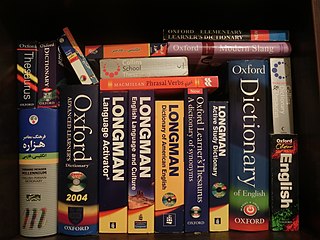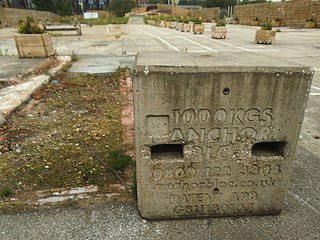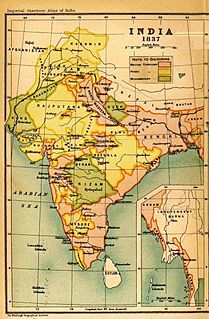Related Research Articles

A dictionary is a listing of lexemes from the lexicon of one or more specific languages, often arranged alphabetically, which may include information on definitions, usage, etymologies, pronunciations, translation, etc.. It is a lexicographical reference that shows inter-relationships among the data.

The inch is a unit of length in the British imperial and the United States customary systems of measurement. It is equal to 1/36 yard or 1/12 of a foot. Derived from the Roman uncia ("twelfth"), the word inch is also sometimes used to translate similar units in other measurement systems, usually understood as deriving from the width of the human thumb.
The pound or pound-mass is a unit of mass used in British imperial and United States customary systems of measurement. Various definitions have been used; the most common today is the international avoirdupois pound, which is legally defined as exactly 0.45359237 kilograms, and which is divided into 16 avoirdupois ounces. The international standard symbol for the avoirdupois pound is lb; an alternative symbol is lbm, #, and ℔ or ″̶.

The ton is a unit of measure. It has a long history and has acquired a number of meanings and uses over the years. It is used principally as a unit of weight. Its original use as a measurement of volume has continued in the capacity of cargo ships and in terms such as the freight ton. Recent specialized uses include the ton as a measure of energy and for truck classification. It is also a colloquial term, "ton" is the heaviest unit of weight typically used in colloquial speech. It is also used informally to mean a large amount of something, material or not.

The tonne is a metric unit of mass equal to 1,000 kilograms. It is commonly referred to as a metric ton in the United States. It is equivalent to approximately 2,204.6 pounds; 1.102 short tons (US) and 0.984 long tons (UK). The official SI unit is the megagram, a less common way to express the same mass.

Published on 15 April 1755 and written by Samuel Johnson, A Dictionary of the English Language, sometimes published as Johnson's Dictionary, is among the most influential dictionaries in the history of the English language.
Long ton, also known as the imperial ton or displacement ton, is the name for the unit called the "ton" in the avoirdupois system of weights or Imperial system of measurements. It was standardised in the thirteenth century. It is used in the United Kingdom and several other British Commonwealth of Nations countries alongside the mass-based metric tonne defined in 1799, as well as in the United States for bulk commodities.

A bushel is an imperial and US customary unit of volume based upon an earlier measure of dry capacity. The old bushel is equal to 2 kennings (obsolete), 4 pecks, or 8 dry gallons, and was used mostly for agricultural products, such as wheat. In modern usage, the volume is nominal, with bushels denoting a mass defined differently for each commodity.

The stone or stone weight is an English and imperial unit of mass equal to 14 pounds. The stone continues in customary use in the United Kingdom and Ireland for body weight.
The slug is a derived unit of mass in a weight-based system of measures, most notably within the British Imperial measurement system and the United States customary measures system. Systems of measure either define mass and derive a force unit or define a base force and derive a mass unit. A slug is defined as the mass that is accelerated by 1 ft/s2 when a net force of one pound (lbf) is exerted on it.
English units are the units of measurement used in England up to 1826, which evolved as a combination of the Anglo-Saxon and Roman systems of units. Various standards have applied to English units at different times, in different places, and for different applications.

The maund is the anglicized name for a traditional unit of mass used in British India, and also in Afghanistan, Persia and Arabia: the same unit in the Moghul Empire was sometimes written as mann or mun in English, while the equivalent unit in the Ottoman Empire and Central Asia was called the batman. At different times, and in different South Asian localities, the mass of the maund has varied, from as low as 25 pounds (11 kg) to as high as 160 pounds (72½ kg): even greater variation is seen in Persia and Arabia.

Textile fibers, threads, yarns and fabrics are measured in a multiplicity of units.
The wey or weight was an English unit of weight and dry volume by at least 900 AD, when it begins to be mentioned in surviving legal codes.
John Cowell was an English jurist.

The candy or candee, also known as the maunee, was a traditional South Asian unit of mass, equal to 20 maunds and roughly equivalent to 500 pounds avoirdupois (227 kilograms). It was most used in southern India, to the south of Akbar's empire, but has been recorded elsewhere in South Asia. In Marathi, the same word was also used for a unit of area of 120 bighas, and it is also recorded as a unit of dry volume.
The last was a Dutch unit of mass, volume, and number, and a large English unit of weight, mass, volume, and number. It referred to standardized amounts of ships' lading and varied by commodity and over time.

The imperial and US customary measurement systems are both derived from an earlier English system of measurement which in turn can be traced back to Ancient Roman units of measurement, and Carolingian and Saxon units of measure.
Tub was a unit of capacity or of weight used in Britain and elsewhere.
The load, also known as a fodder, fother, and charrus, is a historic English unit of weight or mass of various amounts, depending on the era, the substance being measured, and where it was being measured. The term was in use by the 13th century, and disappeared with legislation from the 1820s onwards. Modern equivalents of historical weights and measures are often very difficult to determine, and figures given here should be treated with caution.
References
- 1 2 "Sarplier". Oxford English Dictionary . Retrieved 23 December 2014.
- 1 2 The Life and Works of Arthur Hall of Grantham. Manchester University Press. 1919. p. 221 . Retrieved 12 June 2016.
sarpler.
- 1 2 Cowell, John (1607). The Interpreter, Or, Booke Containing the Signification of Words: Wherein is Set Forth the True Meaning of All, Or the Most Part of Such Words and Terms as are Mentioned in the Law-writers ... Laws, Statutes, Or Other Antiquities. The Lawbook Exchange. ISBN 9781584772651 . Retrieved 12 June 2016.
- ↑ "What is the unit called a sarpler?". www.sizes.com. Retrieved 16 April 2021.